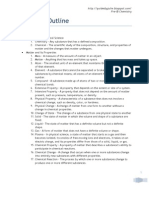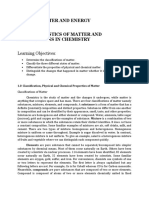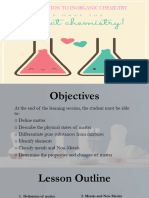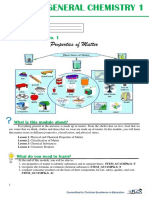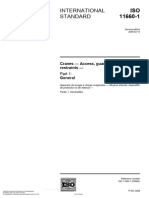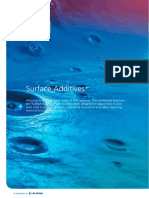Topic Outline:: Salcedo, Eastern Samar 6807 Eastern Samar, Philippines
Topic Outline:: Salcedo, Eastern Samar 6807 Eastern Samar, Philippines
Uploaded by
Megan AldeCopyright:
Available Formats
Topic Outline:: Salcedo, Eastern Samar 6807 Eastern Samar, Philippines
Topic Outline:: Salcedo, Eastern Samar 6807 Eastern Samar, Philippines
Uploaded by
Megan AldeOriginal Title
Copyright
Available Formats
Share this document
Did you find this document useful?
Is this content inappropriate?
Copyright:
Available Formats
Topic Outline:: Salcedo, Eastern Samar 6807 Eastern Samar, Philippines
Topic Outline:: Salcedo, Eastern Samar 6807 Eastern Samar, Philippines
Uploaded by
Megan AldeCopyright:
Available Formats
Grade 11
1st Quarter
Topic: Matter and Its Properties
Content Standard: the learners should demonstrate an understanding of the properties
of matter and its various state.
Performance Standard: The students should be able to recognize the different
substances that made up of Matter.
MELCs: Identify the properties of Matter
MELCs code: STEM_GC11MP-Ia-b-1
Learning Objectives:
At the end of the topic, 80% of the Grade 11 students will be able to:
1. Distinguish the different states of matter.
2. Relate the properties of matter to its specific state.
3. Explain how the properties of liquids and gases characterizes fluids
TOPIC OUTLINE:
I. Three States of Matter
a.Solid – relatively rigid, definite volume and shape. In solid, the atoms and molecules are
attached to each other.
b.Liquids – has definite volume but able to change shape by flowing. In a liquid, the atoms
and molecules are loosely bonded.
c.Gases – no fixed shape, no fixed volume, very compressible
II. The Properties of Matter
a. Physical Properties
Extensive properties
Intensive properties
b. Chemical Properties
III. Liquids and Gases as Fluids
Salcedo, Eastern Samar 6807
Eastern Samar, Philippines
essu_salcedo@yahoo.com.
https://essu.edu.ph
TOPIC CONTENT
Topic: Matter and Its Properties
I. Three States of Matter
The three states of matter are the distinct physical forms that matter can take. These are solid,
liquid, and gas.
a. Solid
Solid matter is composed of tightly packed particles. The forces between the particles
are strong enough that the particles cannot move freely; they can only vibrate. As a result, a
solid has a stable, definite shape and a definite volume. Solids can only change shape under
force, as when broken or cut.
b. Liquid
Liquid matter is made of more loosely packed particles. A liquid is a fluid that conforms
to the shape of its container but that retains a nearly constant volume independent of pressure.
Liquids have the following characteristics: 1) No definite shape (takes the shape of its
container); 2) Has definite volume; 3) Particles are free to move over each other, but are still
attracted to each other.
c. Gas
Gas molecules have either very weak bonds or no bonds at all, so they can move freely
and quickly. Because of this, not only will a gas conform to the shape of its container, it will also
expand to completely fill the container. Gases have the following characteristics: 1) No definite
shape (takes the shape of its container); 2) No definite volume; 3) Particles move in random
motion with little or no attraction to each other; and 4) Highly compressible.
II. The Properties of Matter
Properties are characteristics that enable us to distinguish one kind of matter from
another. The properties of matter include any traits that can be measured, such as an object’s
density, color, mass, volume, length, malleability, melting point, hardness,
odor,temperature,and, and more.
There two properties of matter which all substance are distinguished by, they ‘’physical
properties’’ and ‘’chemical properties’’.
a. Physical Properties: include size, shape, color, texture, etc. The melting point
and freezing point are also physical properties. Every substance has some physical properties
that are different from those of other substances. Physical properties can be changed,
sometimes permanently and sometimes irreversibly. For example, when ice melts the water can
then be refrozen but when the wood is burned many of its atoms leave as gas (carbon dioxide
and water vapour), and the match cannot be put back together to its original state.
Salcedo, Eastern Samar 6807
Eastern Samar, Philippines
essu_salcedo@yahoo.com.
https://essu.edu.ph
Physical properties can extensive or intensive properties. Extensive properties vary
with the amount of the substance and include mass, weight, and volume. Intensive properties,
in contrast, do not depend on the amount of substance; they include color, melting point, boiling
point, electrical conductivity, and physical state at a given temperature.
Examples of Physical Properties:
Odor
Color
Density
Luster
Malleability
Ductility
Hardness
Melting/Freezing point
Boiling point
Conductivity
b. Chemical Properties: characteristics that have to do with the chemical makeup of a
substance, or how it reacts with other substances. This absolutely describe how matter changes
into a completely new, different substance. Flammability and reactivity are examples of
chemical properties.
Examples of Chemical Properties:
Reactivity
Ionization
Combustibility
Flammability
III. Liquids and Gases as Fluids
At a molecular level, liquids have some properties of gases and some of solids. First,
liquids share the ability to flow with gases. Both liquid and gas phases are fluid, meaning that
the intermolecular forces allow the molecules to move around.
Prepared by: Megan A. Alde
Reviewed and Approved by: MARY ANN B. SABADLAB
Salcedo, Eastern Samar 6807
Eastern Samar, Philippines
essu_salcedo@yahoo.com.
https://essu.edu.ph
You might also like
- 2008 R6 Kit ManualDocument61 pages2008 R6 Kit ManualBender Rodriguez100% (3)
- Chapter 1 OutlineDocument4 pagesChapter 1 Outlinedill1233No ratings yet
- Matter and Its PropertiesDocument10 pagesMatter and Its PropertiesGerald CatiponNo ratings yet
- G11 - Q1 Summarizing Notes - 2023-w1Document11 pagesG11 - Q1 Summarizing Notes - 2023-w1Shahd SamehNo ratings yet
- Module Shs Chem1Document4 pagesModule Shs Chem1Ansel SotnasNo ratings yet
- GENERAL CHEMISTRY 1 - Lesson 1Document8 pagesGENERAL CHEMISTRY 1 - Lesson 1Fernandez, Nadine Kate T.No ratings yet
- Chapter-Iii. Matter and EnergyDocument9 pagesChapter-Iii. Matter and EnergyNIEL RYAN HIZOLENo ratings yet
- Lesson 1.04 Chemistry NotesDocument6 pagesLesson 1.04 Chemistry Notescamaron123No ratings yet
- Unit 2 Matter and EnergyDocument8 pagesUnit 2 Matter and EnergyAngelika Barte MulletaNo ratings yet
- Gen Chem 1 Q1Mod1Document23 pagesGen Chem 1 Q1Mod1Joselito UbaldoNo ratings yet
- Chemistry 101-Ch 1 NotesDocument1 pageChemistry 101-Ch 1 NotesChris HussNo ratings yet
- 3rd Quarter Science 8Document12 pages3rd Quarter Science 8RICHARD MACADINENo ratings yet
- Science 8: Quarter 3 Week 1 and 2Document12 pagesScience 8: Quarter 3 Week 1 and 2Baja, Ysabelle Rose B.No ratings yet
- 01 04 JournalDocument3 pages01 04 JournalAkshay KarthikNo ratings yet
- General Chemistry 1: Quarter 1 - Module 1: Describing MatterDocument16 pagesGeneral Chemistry 1: Quarter 1 - Module 1: Describing MatterJohn Paul Recopuerto ParachaNo ratings yet
- Week 2Document3 pagesWeek 2Prima LebananNo ratings yet
- Module 1 Lesson 1Document60 pagesModule 1 Lesson 107 JAVIER LLYOD GENELSON B.No ratings yet
- Science 3 - Q1-W2 - Properties of MatterDocument36 pagesScience 3 - Q1-W2 - Properties of Mattersteph ebonaNo ratings yet
- Module 2 Advanced ChemistryDocument18 pagesModule 2 Advanced Chemistryxyrruschloe06No ratings yet
- Lesson 1.1 Prooperties of MatterDocument4 pagesLesson 1.1 Prooperties of MatterEDMARNo ratings yet
- Lesson 3-Kinetic Molecular TheoryDocument16 pagesLesson 3-Kinetic Molecular TheoryTeacher JoanNo ratings yet
- Physical and Chemical Properties PDFDocument9 pagesPhysical and Chemical Properties PDFshehryar khanNo ratings yet
- EGED 101 MODULE 2 Teaching ScienceDocument27 pagesEGED 101 MODULE 2 Teaching ScienceTrisha MedidasNo ratings yet
- Self-Learning Module in General Chemistry 1 LessonDocument9 pagesSelf-Learning Module in General Chemistry 1 LessonGhaniella B. JulianNo ratings yet
- ChemistryDocument32 pagesChemistryAndrei Angelo PantigNo ratings yet
- GEN CHEMISTRY 1 MODULE (Midterm)Document37 pagesGEN CHEMISTRY 1 MODULE (Midterm)Crisanta GanadoNo ratings yet
- Components of MatterDocument19 pagesComponents of MatterJerry PrestoNo ratings yet
- Chapter 2 Classification of MatterDocument7 pagesChapter 2 Classification of MatterPatrice Francisco100% (1)
- CHAPTER-solid State Part 1Document2 pagesCHAPTER-solid State Part 1Arpandeep KaurNo ratings yet
- ModuleDocument7 pagesModuleapi-353861615100% (1)
- Science Reviewer MATTERDocument3 pagesScience Reviewer MATTERRACHELL SATSATINNo ratings yet
- Module 5 Mathematics, Science, and TechnologyDocument3 pagesModule 5 Mathematics, Science, and TechnologyMarianne Bag-aoNo ratings yet
- Intro To Inorg ChemDocument40 pagesIntro To Inorg Chemelizabethabraham310No ratings yet
- Chemistry Lesson Note Two For Grade 11Document3 pagesChemistry Lesson Note Two For Grade 11Amanuel Tesfaye100% (1)
- Module 1 Matter and Its PropertiesDocument7 pagesModule 1 Matter and Its PropertiesCian Gilmore BuenNo ratings yet
- Properties and Changes of MatterDocument21 pagesProperties and Changes of MatterMiraNo ratings yet
- Structure and Properties of Solids Helps Us To Make Solids of Desired PurposeDocument37 pagesStructure and Properties of Solids Helps Us To Make Solids of Desired PurposeSam JonesNo ratings yet
- Week - q1 State of MatterDocument21 pagesWeek - q1 State of Matterjustine alinaNo ratings yet
- MatterDocument34 pagesMatterJimarie CarilNo ratings yet
- Gen-Chem-1 Handout Q1 Week1Document4 pagesGen-Chem-1 Handout Q1 Week1Daphnie Pauleen PalomarNo ratings yet
- Chemistry: Matter: Sci 1 Teaching Science in The Elementary GradesDocument10 pagesChemistry: Matter: Sci 1 Teaching Science in The Elementary GradesANALIZA ABUDA100% (1)
- Module 1 - General Chemistry 1 (Final)Document7 pagesModule 1 - General Chemistry 1 (Final)Mutsumi JingujiNo ratings yet
- CH 1 Matter in Our Surroundings 3Document58 pagesCH 1 Matter in Our Surroundings 3SHIVAKUMAR H PNo ratings yet
- Learning Module BTECH TBC - Part1.chem Module1Document9 pagesLearning Module BTECH TBC - Part1.chem Module1Jen LabaoNo ratings yet
- Chaper 1 PTDocument53 pagesChaper 1 PTbiniyam aberaNo ratings yet
- 12 STM 005Document4 pages12 STM 005mavelmaxvelNo ratings yet
- Chemistry I Properties of Matter Chase ChastainDocument1 pageChemistry I Properties of Matter Chase Chastaincchastain001No ratings yet
- SCI8 Q3 M1 The Particle Nature of MatterDocument14 pagesSCI8 Q3 M1 The Particle Nature of MatterAlthea De LeonNo ratings yet
- Grade 7 Integrated Science - 2021 - Term 2 - 230816 - 091543Document292 pagesGrade 7 Integrated Science - 2021 - Term 2 - 230816 - 091543Chamika TNo ratings yet
- Integrated Science Grade 7 Weeks 1 - 4 Term 2Document93 pagesIntegrated Science Grade 7 Weeks 1 - 4 Term 2easylearning83No ratings yet
- Unit 2 - Matter and Energy Characteristics of Matter and CALCULATION IN ChemistryDocument4 pagesUnit 2 - Matter and Energy Characteristics of Matter and CALCULATION IN ChemistryTwice OnceNo ratings yet
- General Chemistry 1 LessonsDocument75 pagesGeneral Chemistry 1 LessonsVon DiocenaNo ratings yet
- Chapter1 (Matter and Its Properties)Document9 pagesChapter1 (Matter and Its Properties)Anyanna MunderNo ratings yet
- GeneralChemistry1 - Quarter1 - Week 1-4Document81 pagesGeneralChemistry1 - Quarter1 - Week 1-4Aze Mamalayan100% (1)
- Characteristics of MatterDocument3 pagesCharacteristics of MatterParimala DhanasekaranNo ratings yet
- Activity 5 Matter and Its PropertiesDocument4 pagesActivity 5 Matter and Its PropertiesAriane DionisioNo ratings yet
- All About MatterDocument9 pagesAll About MatterJC UNGRIANo ratings yet
- Chem 113E Module 1Document11 pagesChem 113E Module 1Christopher Lirasan Jr.No ratings yet
- CA Lesson 1 Properties of MatterDocument17 pagesCA Lesson 1 Properties of Matterjj6dhhnphgNo ratings yet
- Children Encyclopedia Chemistry: The World of KnowledgeFrom EverandChildren Encyclopedia Chemistry: The World of KnowledgeRating: 5 out of 5 stars5/5 (3)
- What You Need to Know About Beautiful Nails: A Better Understanding of Nail ChemistryFrom EverandWhat You Need to Know About Beautiful Nails: A Better Understanding of Nail ChemistryNo ratings yet
- Malefic Planet As Per LagnaDocument6 pagesMalefic Planet As Per Lagnajaiswal.utkarshNo ratings yet
- The Truth About Leadership Outline PDFDocument7 pagesThe Truth About Leadership Outline PDFRizka Lashirah SafitriNo ratings yet
- Iso 11660-1-2008Document28 pagesIso 11660-1-2008Rami GhorbelNo ratings yet
- Laboratory Manual: Vi Semester B.E. CseDocument63 pagesLaboratory Manual: Vi Semester B.E. CseAnonymous eVJqhUwebqNo ratings yet
- Nursing Issue PPDocument10 pagesNursing Issue PPapi-634345342No ratings yet
- Limiting Reactants Worksheet 1 AND 2Document4 pagesLimiting Reactants Worksheet 1 AND 2nicoleelizabetharcherNo ratings yet
- Bookeeper Proposal Letter SampleDocument3 pagesBookeeper Proposal Letter SampleEdmark100% (1)
- Concatenate Two SLL Into One: Pseudo CodeDocument11 pagesConcatenate Two SLL Into One: Pseudo CodePranava Raman BMSNo ratings yet
- Third Cycle ProgramsDocument3 pagesThird Cycle Programsbeauty rajaNo ratings yet
- Akita 2020Document10 pagesAkita 2020GERARDO TORRES RUIZNo ratings yet
- Surface AdditivesDocument24 pagesSurface AdditivesHai PhongNo ratings yet
- 3.2 - Chapter I To Bibliography - 110927Document32 pages3.2 - Chapter I To Bibliography - 110927Zae zoeNo ratings yet
- CL - 5 Maths Combined PDFDocument19 pagesCL - 5 Maths Combined PDFTechno Gaming OfficialNo ratings yet
- TA500 Ignition System Analyser Operation ManualDocument9 pagesTA500 Ignition System Analyser Operation ManualKarlitosmanNo ratings yet
- Edexcel AS Drama and Theatre Studies Student Book: ISBN 9781846902406Document3 pagesEdexcel AS Drama and Theatre Studies Student Book: ISBN 9781846902406pubaciNo ratings yet
- Dwnload Full Statistics For Business Decision Making and Analysis 2nd Edition Stine Solutions Manual PDFDocument36 pagesDwnload Full Statistics For Business Decision Making and Analysis 2nd Edition Stine Solutions Manual PDFwellbornfinikin407k2o100% (21)
- Asterisx Limpio Results - Fortify Security ReportDocument46 pagesAsterisx Limpio Results - Fortify Security ReportXiamir LuquezNo ratings yet
- Progress Test 2 BlueDocument2 pagesProgress Test 2 BlueAlvaro Ceballos CastillaNo ratings yet
- Solidworks 2010Document197 pagesSolidworks 2010Jie RongNo ratings yet
- Daewoo Training Washing MachineDocument21 pagesDaewoo Training Washing MachinevictorNo ratings yet
- Taylor and Mayo's Schools of ThoughtDocument3 pagesTaylor and Mayo's Schools of ThoughtTharindu Dasun WeerasingheNo ratings yet
- Politics of Globalisation QP 2019 - TutorialsDuniyaDocument5 pagesPolitics of Globalisation QP 2019 - TutorialsDuniyasatyam kumarNo ratings yet
- Mail MergeDocument12 pagesMail MergesindhuNo ratings yet
- AstroCel I - Prod - Mark - Broch - AFP 1 110BDocument4 pagesAstroCel I - Prod - Mark - Broch - AFP 1 110Bjonathan Reano MendozaNo ratings yet
- TTRC Website ArticlesDocument4 pagesTTRC Website ArticlesPradeep JainNo ratings yet
- 7 Times Table Maths Mastery MatDocument2 pages7 Times Table Maths Mastery MatPooja MaldikarNo ratings yet
- Latex All SymbolsDocument98 pagesLatex All SymbolsJeremy van der HeijdenNo ratings yet
- Proposal BinodDocument16 pagesProposal BinodbinuNo ratings yet
- Lubrication Features of A Large Diesel EngineDocument17 pagesLubrication Features of A Large Diesel EngineKarim Sowley DelgadoNo ratings yet

